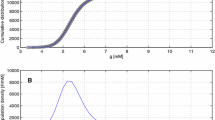Abstract
A mathematical study of the size of a population ofdiabetes mellitus patients is carried out in this paper. The study also monitors the number of patients with complications. By appropriate definition of a parameter, the mathematical model may be classified as linear or non-linear. The non-linear case is discussed and the critical values of the population are analysed for stability. Numerical methods are developed for solving the model equations and the results of numerical simulations are reported.
Similar content being viewed by others
Abbreviations
- t :
-
time
- l :
-
increment int (the time step)
- C(t) :
-
number of diabetics with complications
- D(t) :
-
number of diabetics without complications
- N(t) :
-
number of diabetics (N = C + D)
- I :
-
incidence ofdiabetes mellitus
- J :
-
Jacobian
- μ :
-
natural mortality rate
- λ :
-
probability of developing a complication
- γ :
-
rate at which complications are cured
- ν :
-
rate at which patients with complications become severely disabled
- δ :
-
mortality rate due to complications
- Θ :
-
μ + δ + γ + ν
- β :
-
parameter used in definition of λ (non-linear model)
- χ1, χ2 :
-
eigenvalues
- C 0,N 0 :
-
initial values ofC andN
- C*, N* :
-
critical-point values ofC andN (continuous system)
- C +,N + :
-
fixed-point values ofC andN (discrete system)
- L :
-
local truncation error
References
BBC WORLD On-line,Diabetes (1999), http://news.bbc.co.uk/2/hi/health/medical_notes/253464.stm
BBC WORLD On-line,Obesity sparks diabetes fears (2004), http://news.bbc.co.uk/2/hi/health/4010469.stm
A. Boutayeb and A. Kerfati,Mathematical models in diabetology, Modelling, Measurement and Control, C44(2) (1994) 53–63.
A. Boutayeb, E. H. Twizell, K. Achouyab and A. Chetouani,A mathematical model for the burden of diabetes and its complications, BioMedical Engineering OnLine,3:20 (2004), http://www.biomedical-engineering-online.com/content/3/1/20
British Diabetic Association [BDA], Balance122 (1994) 47.
British Diabetic Association [BDA],Diabetes in the United Kingdom (1996).
Equilibre, Publication de l’AFD,185 (1990) 20–21.
International Diabetes Federation [IDF],IDF Report 2003, www.idf.org/home/index.cfm
S. Kenchaiah, J. C. Evans, D. Levy, E. J. Benjamin, M. G. Larson, W. B. Kannel and R. S. Vasan,Obesity and the risk of heart failure, New England Journal of Medicine347 (2002), 305–313.
H. M. J. Krans, M. Porta and H. Keen,Diabetes Care and Research in Europe, The Saint Vincent Declaration Action Programme, WHO Regional Office for Europe (1992) 53.
J. D. Lambert,Numerical Methods for Ordinary Differential Systems: The Initial Value Problem, John Wiley & Sons, Chichester, 1991.
E. H. Twizell, A. Boutayeb, and K. Achouyab, Department of Mathematical Sciences Technical Report TR/04/01, Brunel University, 2001.
World Health Organisation [WHO],The World Health Report 2002: Reducing Risk: Promoting a Healthy Life (2002), http://www.who.int/whr/2002/en
World Health Organisation [WHO],The World Health Report 2003: Today’s Challenges, Geneva (2003), http://www.who.int/whr/2003/en
World Health Organisation [WHO],Diet, Nutrition and the Prevention of Chronic Diseases: Report of Joint WHO/FAO Expert Consultation, WHO Technical Report Series 916, Geneva (2003).
Author information
Authors and Affiliations
Corresponding author
Additional information
Dedicated to David M. Bartlett and Wiam Boutayeb
Rights and permissions
About this article
Cite this article
Boutayeb, A., Chetouani, A., Achouyab, A. et al. A non-linear population model of diabetes mellitus. J. Appl. Math. Comput. 21, 127–139 (2006). https://doi.org/10.1007/BF02896393
Issue Date:
DOI: https://doi.org/10.1007/BF02896393




